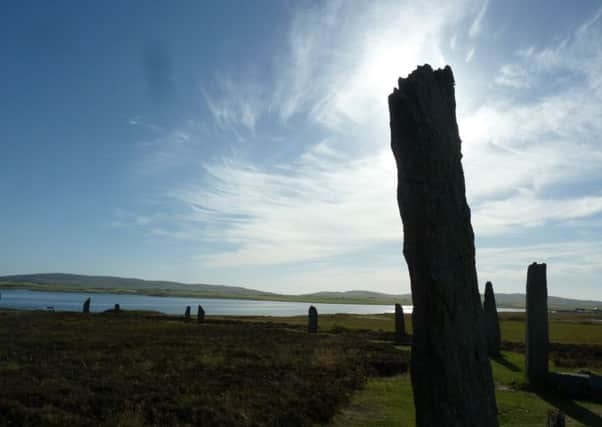Travel review: Orkney Islands


As the ferry pulls away, Steven Ritch walks up the pier and scans the island stretching out in front of him. “People from the South come up here and think it’s very romantic,” he says. “But we can be cut off in winter. Sometimes you can’t see the pier for the waves.”
We’ve just come ashore on Graemsay, one of the smaller Orkney islands, up off the top right hand corner of Scotland. My wife and I have been visiting Orkney for over 25 years and Graemsay, with its population of just 27, has always tantalised us.
Advertisement
Hide AdAdvertisement
Hide AdAt the northern entrance to Scapa Flow and dwarfed by the high hills of nearby Hoy (as in “Old Man of...”), it’s less than a mile offshore, but has always seemed a challenge to get to. Which is another way of saying we’ve never got to grips with the ferry timetable.
In any case, there’s always been more than enough on Orkney to occupy us. We’ve visited, and revisited, the amazing neolithic remains on the biggest of the 70 islands, the confusingly named Mainland.
We’ve edged around the prehistoric village of Skara Brae, crawled inside the strangely cosy chambered cairn of Maes Howe, and marvelled at the Ring of Brodgar, a great wheel of monoliths under a vast sky. Travel offers few more inspiring experiences than having Brodgar to yourself at six o’clock on a summer morning, with the sun shimmering on the lochs on either side of it. We’ve spent countless hours in Kirkwall, Orkney’s “capital”, absorbing its Viking cathedral of St Magnus and nosing round its fine museum.
And we’ve explored the back lanes of Stromness, Orkney’s second biggest town and a strange little Hans Christian Andersen sort of place, with a huddled, secretive air and an alley called Khyber Pass.
Advertisement
Hide AdAdvertisement
Hide AdWe’ve watched thousands of seabirds wheeling over the towering wave-lashed cliffs at Marwick Head. We’ve walked the lyrical landscape and sailed the lyrical seascape, taking ferries to most of the other 19 inhabited smaller islands. But not Graemsay. Until now.
Spurred on by one guidebook’s description of it as “a comely island”, and another’s suggestion that it lets you “step back in time”, we’ve finally grappled with the ferry timetable and sat down with a map.
Graemsay, we see, is a mile-and-a-half long and a mile wide. It has two low hills, two lighthouses and two dozen widely scattered houses, a couple with names that give strong hints of likely weather: Windbreck and Windywalls. Its coastal features sound beguilingly strange: Croo Taing, Fulzie Geo, Sow Skerry, Gangsti, Skeafea, The Nevi. It’s like an Orcadian take on Tolkien.
The population peaked at 230 in the 1880s, with most people farming, fishing, working on whalers or with the Hudson’s Bay Company: lives combining tradition and adventure. But the numbers have steadily declined since then. The school closed 20 years ago and children now take the ferry to school in Stromness.
Advertisement
Hide AdAdvertisement
Hide AdThe ferry timetable means we’ll have just a couple of hours on the island, a taster trip, a mere glimpse of Graemsay, but at least we’re going. So at 4pm, we join the dozen or so passengers waiting on Stromness pier for the ferry, some bound for Graemsay, some going on to Hoy.
They have a fine array of very full shopping bags and trolleys with them; many islanders make a weekly provisions trip to Stromness. There’s no shop on Graemsay, but there is a post office: open for three days a week, two hours at a time.
The journey takes 15 minutes, one of the shortest Orkney ferry journeys (the one to North Ronaldsay, the most northerly island, takes just short of three hours).
Once ashore on Graemsay, we walk up the hill from the pier with Steven, whose mother and father settled here to farm. Is the island peaceful, I ask. “Reasonably,” he says. Is there a sense of community? “Near enough.”
Advertisement
Hide AdAdvertisement
Hide AdAnd then he talks about the corncrakes. “We’ve got one who crek-creks away all night,” he says and gets out his mobile phone to play us a recording of its characteristic rasping call. “It can make that call 20,000 times in six hours,” he adds ruefully. And gets into his car and drives off.
He leaves near-silence behind him. All we can hear is the sea, a low wind and birds – particularly burbling curlews. Oystercatchers stalk fields rich with flowers, and there are swallows, redshanks, lapwings and the odd skua.
We see no-one as we follow the road, past grazing sheep and cattle and abandoned crofts. Along a path high-banked by hedgerows, we discover a broad sandy bay, with the great dark hump of Hoy brooding behind it. We sit for 20 minutes gazing at the waves white-flecking the sea. And then it’s time to head back to the ferry.
As we reach the pier, a grey curtain of rain blows in and we shelter in the waiting room. “The absolute island,” Tristan from Paris has written in the visitors’ book. Pinned up on the wall is a ferry timetable: for 2004. Step back in time, like the guidebook said.
Advertisement
Hide AdAdvertisement
Hide Ad• Orkney can be reached by four different ferry routes from the Scottish mainland or by air from Manchester and Leeds Bradford. Details (and information about ferries to Graemsay) from Visit Orkney (01856 872856, www.visitorkney.com).
The Kirkwall Hotel (01856 872232, www.kirkwallhotel.com) has a commanding position overlooking Kirkwall harbour. B&B doubles from £95; slightly more for a sea view (recommended). It has an excellent restaurant and popular bar.